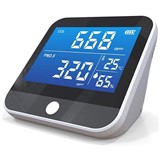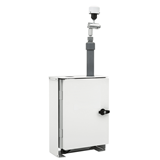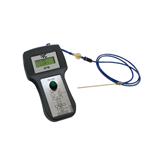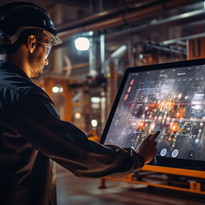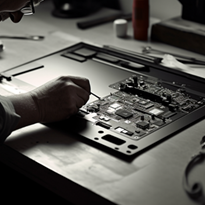The introduction of industrial touch screen monitors has revolutionized the way operators interact with machinery and control systems, offering intuitive interfaces, multi-touch capabilities, and advanced gesture controls. These technological advancements have redefined human-machine interaction, empowering industrial professionals to operate with unprecedented efficiency and precision.
In this comprehensive guide, we delve into the transformative impact of industrial touch screen monitors on industrial productivity. Industrial touch screen monitors have emerged as powerful tools that streamline operations and enhance user experience.
By incorporating intuitive touch interfaces, operators can navigate complex processes with ease, eliminating the need for cumbersome manual controls and reducing the learning curve for new users.
The ability to access critical data and real-time updates with a simple touch enables operators to make informed decisions promptly, optimizing operational efficiency and response times. Furthermore, multi-touch functionality empowers operators to perform multiple tasks simultaneously, fostering efficient multitasking and collaboration in control centers and industrial environments.
With gestures like pinch-to-zoom and pan, operators can examine intricate details in design and engineering processes, leading to enhanced accuracy and improved overall performance. The design of the user interface plays a crucial role in enhancing the overall user experience. By incorporating clear and readable fonts, intuitive icons, and visual cues, industrial touch screen monitors provide operators with a familiar and user-centric environment. Consistent layout across screens reduces cognitive load and enables faster navigation, while customizable dashboards ensure that operators have the most relevant data at their fingertips.
1. Streamlining Operations with Intuitive Touch Interface:
Incorporating intuitive touch interfaces in industrial environments can significantly streamline operations and enhance productivity. Here are the key points to consider:
- User-Friendly Navigation: Intuitive touch interfaces eliminate the need for complex menus and controls, providing straightforward and user-friendly navigation for operators. A clear and well-organized interface ensures that operators can easily access the required functions without spending time on unnecessary steps.
- Faster Access to Information: Industrial touch screen monitors offer quick access to critical data, real-time updates, and control options, allowing operators to make informed decisions promptly. With a simple touch, operators can obtain real-time data on equipment status, production metrics, and process parameters, enabling them to respond swiftly to changing conditions.
- Reduced Learning Curve: Intuitive touch interfaces lower the learning curve for new operators, enabling them to become proficient in operating the machinery more rapidly. The familiar touch-based interactions, similar to smartphones and tablets, make it easier for operators to adapt to the touch screen interface, saving time on training.
- Simplified Settings and Adjustments: Touch interfaces simplify the process of making settings and adjustments, reducing the time spent on configuration and fine-tuning. Operators can calibrate equipment, adjust parameters, and set up processes with a few simple touches, minimizing downtime and increasing operational efficiency.
- Customizable Dashboards: Tailoring dashboards to display essential information empowers operators with data visualization that aligns with their specific roles and responsibilities. Customizable dashboards allow operators to create personalized views that show the most relevant data, ensuring they have the information they need at their fingertips.
2. Multi-Touch Functionality: Enabling Efficient Multi-Tasking
Multi-touch functionality in industrial touch screen monitors empowers operators to perform multiple tasks simultaneously, enhancing efficiency in industrial environments through the following ways:
-
Simultaneous Inputs
Multi-touch capability allows operators to execute multiple touch inputs at the same time. With the ability to use multiple fingers or touch points on the screen, operators can perform various actions concurrently. This feature enables operators to interact with different elements of the interface simultaneously, reducing the need for sequential operations and accelerating overall task completion.
-
Zoom and Pan
In industrial applications that involve detailed data visualization, such as schematics, engineering drawings, or complex graphs, multi-touch gestures like pinch-to-zoom and pan are invaluable. Operators can zoom in on specific areas of interest and pan across large diagrams effortlessly. This enables them to examine intricate details, identify anomalies, and make informed decisions quickly and accurately.
-
Multi-Tasking in Control Centers
In control centers where operators monitor and control multiple processes or machinery, multi-touch functionality becomes a game-changer. Operators can interact with different screens or applications on the same touch screen monitor, allowing them to manage various tasks simultaneously. For example, an operator can monitor equipment status on one screen while adjusting settings on another, all within the same touch interface.
-
Enhanced Collaboration
In collaborative industrial environments, multi-touch capabilities foster seamless teamwork. Multiple operators can interact with the same touch screen monitor simultaneously, making collaborative decision-making more efficient. This feature is particularly useful in control rooms or during maintenance tasks that require coordinated efforts.
-
Support for Gloved Hand
Certain industrial settings necessitate the use of protective gloves for operator safety. Multi-touch screens can accommodate gloved inputs, ensuring uninterrupted workflow in these environments. This capability is critical in industries where operators need to handle hazardous materials or work in extreme conditions.
-
Customizable Gestures
Modern industrial touch screen monitors often support customizable gestures, allowing operators to define specific touch patterns to trigger certain functions or shortcuts. By customizing gestures to align with their workflow, operators can optimize their touch interactions and tailor the touch screen monitor to their specific needs.
-
Improving Efficiency and Responsiveness
With multi-touch functionality, industrial touch screen monitors become more responsive and intuitive to use. Operators can interact with the interface using natural and familiar gestures, similar to using smartphones or tablets. This familiarity leads to reduced learning curves and faster adoption of the touch screen technology, further enhancing efficiency in industrial environments.
Multi-touch functionality in industrial touch screen monitors empowers operators to perform multiple tasks simultaneously, unlocking new levels of efficiency and productivity in industrial settings. From zooming and panning to support for gloved hands and enhanced collaboration, multi-touch capabilities enable operators to interact with the interface seamlessly and make quicker, more informed decisions. As the industrial landscape continues to evolve, multi-touch functionality will play an increasingly vital role in optimizing operations and driving productivity to new heights.
3. Intuitive User Interface Design: Enhancing User Experience
The design of the user interface on industrial touch screen monitors plays a crucial role in enhancing the overall user experience. Here are the key points to consider:
- Clear and Readable Fonts: Choosing clear and readable fonts for the user interface ensures that operators can easily read and comprehend information displayed on the screen. Legible fonts reduce the chance of misinterpretation and improve overall user satisfaction.
- Iconography and Visual Cues: Intuitive icons and visual cues guide operators through various functions, reducing the need for textual instructions and minimizing errors. Well-designed icons with clear representations of functions allow operators to navigate the touch screen interface with ease.
- Color Coding and Highlighting: Using color coding and highlighting important elements draws operators' attention to critical information and alerts. For example, color-coded indicators for equipment status or process alarms can quickly convey essential information.
- Consistent Layout: Maintaining a consistent layout across different screens and applications improves familiarity and speeds up operator response time. A consistent layout reduces the cognitive load on operators, enabling them to navigate the interface effortlessly.
- User-Centric Design: Involving end-users in the design process ensures that the user interface aligns with their preferences, workflow, and efficiency requirements. User feedback and input are invaluable for identifying pain points and improving the overall user experience.
4. Advanced Gesture Controls: Optimizing User Interactions
Advanced gesture controls take touch screen interactions to the next level, enabling more intuitive and efficient user interactions. Here are the key points to consider:
- Swipe and Scroll: Gestures like swiping and scrolling allow operators to navigate through long lists or pages quickly. For example, operators can swipe through a list of data entries or scroll through a log of events.
- Rotate and Zoom: The ability to rotate images or 3D models and zoom in for detailed inspections enhances accuracy and precision. In design and engineering applications, operators can rotate 3D models to examine them from different angles.
- Two-Finger Gestures: Two-finger gestures, such as two-finger tap or double-tap, can be customized for specific functions, improving the user experience. For instance, a two-finger tap could trigger a predefined shortcut or function.
- Flick and Throw: Gestures like flicking or throwing objects on the screen facilitate rapid selection and movement of items. In certain applications, operators can flick objects to move them between different sections of the interface.
- Customizable Gestures: Industrial touch screen monitors with customizable gesture controls allow operators to tailor interactions to their specific needs and tasks. Customizable gestures enhance user efficiency by enabling operators to define gestures that align with their workflow.
5. Touch Screen Software and Application Compatibility
The compatibility of industrial touch screen monitors with industrial software and applications is vital for seamless integration and efficient performance. Here are the key points to consider:
- Operating System Compatibility: Industrial touch screen monitors should support the operating systems used in the industrial environment, such as Windows or Linux. Full compatibility ensures that the monitor can run the required software smoothly.
- Application Interfaces: The touch screen should be able to accommodate the interface requirements of various industrial applications. Different applications may have distinct interface layouts, and the touch screen should be adaptable to these variations.
- Driver Support: Ensuring driver compatibility with the target operating system is crucial for proper functioning and touch accuracy. Reliable drivers enable the touch screen monitor to interpret touch inputs accurately.
- Custom Integration: Industrial touch screen monitors should allow for custom integration with industrial software, enabling tailored functionality and data exchange. Custom integration ensures that the touch screen can work seamlessly with specialized applications.
6. Time-Saving Features and Shortcuts for Industrial Workflows
Time-saving features and shortcuts integrated into industrial touch screen monitors can significantly boost industrial productivity. Here are the key points to consider:
- Quick Access Buttons: Customizable quick access buttons enable operators to access frequently used functions or settings with a single touch. Operators can set up shortcut buttons to access critical functions without navigating through multiple screens.
- Saved Presets and Profiles: The ability to save and load presets or user profiles streamlines workflows, particularly for repetitive tasks. For example, operators can save specific configurations for different production runs and load them as needed.
- Gesture-Based Shortcuts: Assigning specific functions to gesture-based shortcuts can speed up operations and reduce the need for navigating through menus. Operators can define custom gestures that trigger specific actions, further enhancing efficiency.
- Voice Command Integration: Industrial touch screen monitors with voice command integration allow hands-free operation for certain tasks, saving time and effort. Voice commands can be used to initiate functions or input data without touching the screen.
- Instant Data Sharing: Seamless data sharing and export features enable operators to transfer data quickly to other systems or devices. This feature is especially useful when operators need to share data with colleagues or analyze it on other devices.
7. Operator Training and Adoption: Maximizing Efficiency in Industrial Processes:
Efficient operator training and smooth adoption of industrial touch screen monitors are essential for maximizing productivity in industrial processes. Here are the key points to consider:
- Comprehensive Training Programs: Providing comprehensive training programs for operators ensures they are proficient in using industrial touch screen monitors and related applications. Training should cover basic touch interactions, multi-touch gestures, and application-specific features.
- Hands-On Practice: Hands-on practice with industrial touch screen monitors allows operators to familiarize themselves with the interface and features. Practical exercises and simulations help build operator confidence and proficiency.
- Clear User Manuals and Resources: Clear and concise user manuals and resources aid operators in troubleshooting and making the most of touch screen features. Comprehensive documentation should be readily available to operators for reference.
- Continuous Support and Feedback: Offering continuous support and gathering feedback from operators helps identify areas for improvement and optimization. Regular communication with operators ensures that any issues are addressed promptly.
- Ergonomic Considerations: Ensuring ergonomic placement and mounting of industrial touch screen monitors enhances operator comfort and reduces fatigue during prolonged usage. Proper ergonomics are essential for maintaining operator productivity and well-being.
Conclusion
Industrial touch screen monitors have undoubtedly emerged as key drivers in boosting industrial productivity. The fusion of intuitive touch interfaces, multi-touch functionality, advanced gesture controls, and application compatibility empowers operators to streamline operations, optimize workflows, and make data-driven decisions. As technology continues to evolve, industrial touch screen monitors are poised to unlock even greater potential in industrial settings.
Industrial touch screen monitors have ushered in a new era of efficiency and effectiveness in industrial processes, paving the way for a more connected and productive industry. As manufacturers and industrial professionals continue to embrace this cutting-edge technology, they can harness its full potential to revolutionize their operations and elevate industrial productivity to unprecedented heights. By staying abreast of the latest developments in touch screen technology and adopting best practices in its implementation, industries can embark on a journey of continuous improvement and growth, forging a brighter and more prosperous future.



-160x160-state_article-rel-cat.png)




